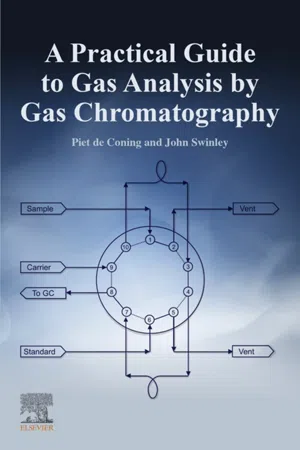
- 440 pages
- English
- ePUB (mobile friendly)
- Available on iOS & Android
A Practical Guide to Gas Analysis by Gas Chromatography
About this book
A Practical Gas Analysis by Gas Chromatography provides a detailed overview of the most important aspects of gas analysis by gas chromatography (GC) for both the novice and expert. Authors John Swinley and Piet de Coning provide the necessary information on the selection of columns and components, thus allowing the reader to assemble custom gas analysis systems for specific needs. The book brings together a wide range of disparate literature on this technique that will fill a crucial gap for those who perform different types of research, including lab operators, separation scientists, graduate students and academic researchers.This highly practical, up-to-date reference can be consulted in the lab to guide key decisions about proper setup, hardware and software selection, calibration, analysis, and more, allowing researchers to avoid the common pitfalls caused by incorrect infrastructure.- Shows, in detail, how valve configurations work, allowing readers to understand the building blocks of extremely complex systems- Presents the complete infrastructure for setting up a gas analysis laboratory in a single source- Includes a full chapter on practical analytical systems for analyzing various gas mixtures
Frequently asked questions
- Essential is ideal for learners and professionals who enjoy exploring a wide range of subjects. Access the Essential Library with 800,000+ trusted titles and best-sellers across business, personal growth, and the humanities. Includes unlimited reading time and Standard Read Aloud voice.
- Complete: Perfect for advanced learners and researchers needing full, unrestricted access. Unlock 1.4M+ books across hundreds of subjects, including academic and specialized titles. The Complete Plan also includes advanced features like Premium Read Aloud and Research Assistant.
Please note we cannot support devices running on iOS 13 and Android 7 or earlier. Learn more about using the app.
Information
Overview and theory
Abstract
Keywords
1.1. Historical overview
1.1.1. Early days
Table of contents
- Cover image
- Title page
- Table of Contents
- Copyright
- Visual glossary
- Introduction
- Chapter 1. Overview and theory
- Chapter 2. Gas analysis laboratory
- Chapter 3. The gas chromatograph
- Chapter 4. Standards, calibration and samples
- Chapter 5. Valves
- Chapter 6. Sampling and sample introduction
- Chapter 7. GC columns for gas analysis
- Chapter 8. GC detectors
- Chapter 9. Data system and data handling
- Chapter 10. Multidimensional gas analysis
- Chapter 11. Practical guidelines for selected gas analysis applications
- Chapter 12. Troubleshooting
- Index